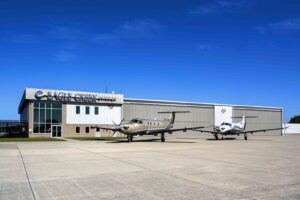Article published in the Indianapolis Business Journal, written by Kurt Christian
New development is taking shape near the expanding Indianapolis Executive Airport in Zionsville, even as local officials are still determining what types of projects would be good neighbors with air traffic.
The town and the Hamilton County Airport Authority launched a study in fall 2018 to plan improvements at the airport and recommend how properties as far as four miles away might be appropriately developed alongside its projected growth.
The draft plan suggests the town establish mixed-use, commercial/industrial, residential and agricultural districts to promote economic development that is compatible with the airport’s federal and operational restrictions.
However, development around the airport is occurring naturally even as that process continues. At least two projects have recently been announced in and adjacent to the study area—including a nearly 1,200-acre solar farm and the redevelopment of a former 216-acre golf course into a nature conservancy. Both could get off the ground before the study’s recommendations take effect.
“It would be nice if we’d done this study five years ago, but it is what it is,” said Bill Frye, president of the Hamilton County Airport Authority board. “We know this area is going to change. It’s not going to be farmland forever. So, let’s think about what makes the most sense, both from the town’s perspective and in terms of the happiness of people who move in her
Frye said the Indianapolis Executive Airport’s growth is a direct result of the area’s growing business climate. The airport straddles the fast-growing Hamilton and Boone counties and is the busiest non-commercial airport in the state that specifically caters to business travel or jet aircraft.
That wasn’t the case in 2003, the last time Zionsville updated its comprehensive plan. Though the town is actively looking to update that plan, several new projects could preempt the developing vision for that area.
“In an ideal world, there would be nothing around us. There’d be no development,” Indianapolis Executive Airport Director Sam Sachs said. “We’ve been lucky so far, in the sense that things are relatively rural around us. In 10 years, is that going to change? The way we’re going, probably.”
Proposed land uses
The town of Zionsville and the Hamilton County Airport Authority commissioned a land-use study to determine how areas around the Indianapolis Executive Airport might be developed.
Guiding growth
Knowing that development was likely coming, the town of Zionsville and the Hamilton County Airport Authority asked Indianapolis-based HWC Engineering in 2018 to conduct a study of strategic land uses for properties surrounding the airport.
Areas just north and south of the existing runway—and a possible future perpendicular runway—have restricted development standards under the Federal Aviation Administration’s regulations for runway protection zones.
Tall structures and trees are non-compatible, as are uses with high noise sensitivities like single-family housing; uses that produce steam, light or glare; large-bird attractions like retention ponds; and uses that attract large groups of people.
The study identified commercial uses that don’t attract large groups of people, industrial, light industrial, agricultural and some residential buildings with advanced soundproofing measures as complementary.
HWC’s draft recommendations propose the following:
◗ 3,500 acres west of U.S. 421 should be preserved for large-lot and conservation housing.
◗ 2,900 acres north of S.R. 32 should remain agricultural, with large minimums for lot sizes.
◗ 400 acres at the southeast corner of U.S. 421 and S.R. 32 should be dedicated as an “Airport Village,” with offices, commercial, retail, hospitality and mixed-use residential uses.
◗ 600 acres immediately east of the airport should be a commercial/industrial district promoting manufacturing, high-tech, health care and other uses that could benefit from direct access to the runway.
◗ 400 acres southwest of the airport along U.S. 421 should be dedicated to mixed-density residential, attached housing, senior community or campus-style housing with limited commercial uses.
◗ Other areas would be preserved for agricultural or agritourism operations.
‘A good neighbor’
Frye said he’s concerned about any type of residential development near the airport because homeowners or renters are likely to complain about noise. Plus, the retention ponds needed for such projects draw geese.
That’s why he favors both the nature conservancy—which would attract small, low-flying songbirds—and the solar farm projects over housing.
“It’s a desirable area to move to here. It’s a growing area,” Frye said. “We want to be a good neighbor, and if people are complaining about you all the time, it’s hard to continue your good-neighbor policy.
“It would be nice to give everybody, ourselves as well as the potential developers, some thought about how the town wants to see that area develop,” he said.
Wayne DeLong, Zionsville’s planning director, said it’s too early to comment on the study’s recommendations since the draft plan has not yet been considered by elected officials. He said HWC’s recommendations could be finalized this summer, but they’d still have to be considered by the town’s plan commission and council before being integrated into Zionsville’s planning documents.
“Certainly, we’re very interested in seeing that move forward in the public process to continue that dialogue,” DeLong said.
Molly Whitehead, executive director of the Boone County Economic Development Corp., said HWC’s recommendations align with her vision for best uses for property surrounding the airport. However, she said, much of the development might still be far off.
“It could be a really cool opportunity for that area to bring in some neat users, but it won’t develop overnight. This will take quite a bit of time,” she said. “Any company—I don’t care if it’s manufacturing, research and development, an office user—they need to have the infrastructure there. It’s rare—not unheard of, but rare—for a company to locate on an unprepared site.”
DeLong acknowledged that development in the area is contingent upon adequate sewer and water infrastructure. Zionsville-based TriCo Regional Sewer Utility provides service up to East County Road 200S, east of U.S. 421. Fishers-based Hamilton Southeastern Utilities has jurisdiction over those areas north of East County Road 200S.
DeLong said it has been a decade since that certificate of territorial authority was granted, and it might be another decade before there are any investments to bring the sewer and water infrastructure needed to support increased development in the area.
Nature habitat
Jim and Nancy Carpenter, owners of Wild Birds Unlimited, purchased the former 216-acre Wolf Run Golf Club at the southwest quadrant of State Road 32 and U.S. 421 for an undisclosed amount in February. It’s about four miles from the airport. The couple’s plan is to redevelop the former 18-hole course that closed in 2017 as a park and nature conservancy.
“It’s a gorgeous piece of property, and having the riparian habitat in there is really special,” said Nancy Carpenter, referring to the way the land and water come together. “There’s quite a bit of topography and gorgeous mature woods you don’t see often in Boone County. We felt it was a really special place with a lot of potential to bring back and give back to nature.”
The Carpenters have purchased real estate across Indiana for conservation purposes for more than two decades. Now, they want to sell the property to Zionsville at a steep discount for it to be turned into a town park and nature conservancy, with a long-term goal of restoring local songbird populations.
Already, the Carpenters have started enhancing the property’s varied habitat, including rehabilitating a portion of Eagle Creek that runs through the property, working on wetland mitigation, eradicating invasive species and installing bird boxes.
“We’re working with the parks department now to develop a letter of intent. We’re trying to put a timeline on it, maybe three to five years,” Carpenter said. “That may be optimistic, but we’d like to see it move quickly.”
Carpenter said she and her husband were not aware of the ongoing land-use study for the airport when they purchased the property. They just wanted to save it from impending development.
“Someday, this is just going to be a sea of houses,” she said. “Somebody has to do something to step up and help the wildlife and pollinators and give human beings a peaceful place to retreat.”
Because the former golf course is roughly at the buffer zone the FAA recommends for wildlife development near an airport, the nature preserve should be able to proceed as planned, said Sam Sachs, director of the Indianapolis Executive Airport.
“In my mind, that’s far enough away. Where the golf course is, it’s out of the way of our typical airport patterns—especially at the points where aircraft are going to be at their lowest altitudes,” he said. “Additionally, songbirds are small birds that fly at relatively low altitudes. Statistically speaking, the most dangerous avian species for aircraft are large birds—geese, vultures, hawks, etc. Ultimately, I do not see a large concern for this proposed development.”
In fact, Frye said a park—even one meant to increase the local bird population—would be a more compatible use than some of the single-family homes that have been developed south of the airport.
Solar farm
Meanwhile, Florida-based NextEra Energy Resources LLC has announced plans for a 200-megawatt solar farm called Brickyard Solar along U.S. 421, between east county roads 200N and 300N, just north of the airport study area.
The company has not yet filed a development petition with the town of Zionsville, but the project has a dedicated website.
According to the website, the proposed design would span nearly 1,200 acres. Though it’s subject to state and local approvals, the project is scheduled to begin operations by the end of 2022.
Representatives for NextEra Energy Resources did not respond to IBJ’s request for comment. Sachs said, much like the proposed nature conservancy, the project is not necessarily a problem.
“Though there is certainly a concern regarding glare, airports actually commonly put solar panels on their property as a way of generating additional revenue or offsetting their utility cost [and] attempting to become more carbon-neutral,” Sachs said, pointing to the solar panels at Indianapolis International Airport.
He said he’s not heard anything about how that solar installment has affected airport growth or operations, but he’s willing to hear more about NextEra Energy Resources’ plan.
“I would assume that the developer of this solar farm would reach out to the airport during their initial design phase to ensure the panel positioning does not affect our operations,” he said.
“So, on the surface, a solar farm is actually a more compatible development near the airport than single-family homes, but ultimately our engineers and/or the FAA would need to examine the proposed location to determine if it would be an impact to the airport or not.”
Growth at the airport
The airport itself is getting busier.
Founded as Terry Airport in 1958, the 200-acre property has seen a steady increase in traffic since the Hamilton County Airport Authority bought it in 2003.
According to the FAA’s traffic-flow management system, the Indianapolis Executive Airport saw a 44% increase in traffic from 2010 to 2019. Sachs said one metric to demonstrate growth in the airport’s use is the 21% increase in fuel sales from 2016 to 2019.
Currently, an $11 million project is underway to extend the airport’s runway 1,500 feet. The airport’s master plan also calls for extending the runway 700 feet to the south and building a 4,000-foot perpendicular runway, for lighter aircraft.
And the airport’s fixed-base operator has improvement plans of its own.
Indianapolis-based First Wing Jet Center plans to spend $4 million to add the airport’s first new hangars in 15 years (not counting the private hangar built for Beck’s Hybrids in 2016).
Construction on two hangars, each with six executive bays, could start as soon as next month and be completed by November, said Sean White, vice president of First Wing.
White said First Wing is at a tipping point in its growth. It stores nearly 100 aircraft, including planes owned by 20 corporations.
There were enough inquiries for the new hangar format that he felt the market demand was clear.
“If we didn’t do something, we’d be running out of space,” White said. “We don’t officially have these sold, but I have a list of interested people that’s about twice as long as the number of hangars I’m building.”





